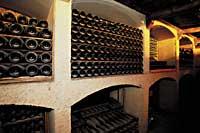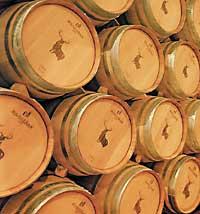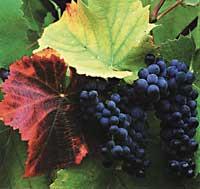Wine in barrels, no more than 12 months
2005/04/01 Kortabitarte Egiguren, Irati - Elhuyar Zientzia Iturria: Elhuyar aldizkaria

The most important compounds of the wine are polyphenols, among them tannins. Tannins are the ones that give color to the wine, but its flavor is very acidic, so to eliminate it it is necessary to have the wine in the cuba. In fact, the oxygen that enters through the pores of the tank reacts with tannins until the wine is heated and the color stabilizes. This is the main reaction that occurs in the barrel, between tannins and oxygen. In addition, Cuba itself also contributes tannins to the wine.
But not only that, the smell of the wine is important in the bes-te and, while aging, the fish itself also releases volatile compounds responsible for the smell of the wine.
The PhD in Chemical Sciences, Teresa Garde Cerdán, of the Public University of Navarra, has studied in her thesis the influence of various factors in this process. And it has come to the striking conclusion that when the wine takes 10 or 12 months in the cuba, the maximum concentration of the compounds released by the wood in the wine is produced.
Moreover, from one year the concentration of these beneficial compounds for the smell of wine not only does not increase but also decreases. On the contrary, according to the current rules, the permanence of the wine in the barrel is twelve or eighteen months, respectively, for wines of great reserve and reserve. Therefore, the contribution of this study is important.

Teresa Garde has analyzed, among other things, the influence of aging time, the composition of wine and the age of the cuba and the type of wood in the smell of wine. It should be taken into account that at present, in general, three oak species are used to produce wine barrels: Quercus pedunculata and European Quercus sessilis and American Quercus alba.
Four experiments
In the thesis he carried out four experiments. In his first experiment, he analyzed a red wine that remained twelve months in American oak and French oak barrels for five years. Subsequently, he analyzed the evolution of black wine that spent 18 months in a French oak barrel used for two years. The other two experiments were carried out with wines of various pH and alcohol grades such as Merlot and Cabernet Sauvignon, made in one year old American oak barrels.
As for the age of the tank, the results obtained by Garde have shown that the old barrels release few volatile compounds. In fact, the five-year basins do not release aromatic compounds, according to researchers. In fact, the older the fish is, the smaller its porosity and, once stuck all the pore (at 6 years), it does not produce any change in the wine.
In addition to age, the type of oak also influences. According to the analysis of the data, although all the tanks released small concentrations of volatile compounds, the French oak tanks released a little larger covers than those of American oak. In addition, the wines cured in the latter had high concentrations of ethylphenol, compounds that damage the smell of wine.
The doctor also analyzed the influence of the time of aging of the wine in the accumulation of volatile compounds to calculate the optimal stay in the wine tank. The maximum concentrations of the compounds released by the wood are obtained when the wine takes in the cuba between 10 and 12 months.

Finally, the theologian observed that the degree of alcohol influenced more than pH in the accumulation of volatile compounds. That is, the wines with the highest degree of alcohol extract from the wood more volatile compounds than wines with the lowest degree of alcohol. The relationship between the degree of alcohol and the ethylphenol deposit is the opposite: to a higher degree of alcohol, less accumulation of ethylphenol.
Currently it is preserved in the winery a minimum of six months of aging, a year of reservation and 18 months of great reservation. After these investigations, things can change. In fact, in this work it is clear that from the twelfth month, as it were, the wine is ‘stabilized’ or the odour producing compounds are reduced.
There are many factors that influence the elaboration of the wine and, due to the research carried out around them, the professionals are increasingly aware of what, when and how it affects the wine.
www.ihobe.net




